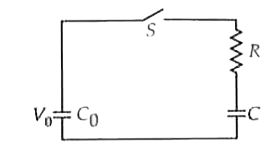A capacitor of capacitance C0 is charged to a patential V0 and then isolated. A small capacitor C is then charged from C0, discharged and charge again, the process being is decreased to V. Find the value of C.
C0(V0V)1n
C0[(V0V)1/n−1]
C0[(VV0)−1]n
C0[(VV0)n+1]
The correct Answer is:B
Potential of larger capacitor after the first chargin g is
V1=C0V0C+C0
After second charging, potential is
V2C0V1(C+C0)=(C0C+C0)2V0
Aftre nth Charging , potential is
Vn=(C0C+C0)nV0
But Vn=V
So C=C0[(V0V)1/n−1].
Topper's Solved these Questions
- BOOK - CENGAGE PHYSICSCHAPTER - CAPACITOR AND CAPACITANCEEXERCISE - Multile Correct11videos
CAPACITOR AND CAPACITANCE
- BOOK - CENGAGE PHYSICSCHAPTER - CAPACITOR AND CAPACITANCEEXERCISE - Comprhension35videos
CAPACITOR AND CAPACITANCE
- BOOK - CENGAGE PHYSICSCHAPTER - CAPACITOR AND CAPACITANCEEXERCISE - Subjective24videos
CAPACITOR AND CAPACITANCE
- BOOK - CENGAGE PHYSICSCHAPTER - ATOMSEXERCISE - QUESTION BANK40videos
ATOMS
- BOOK - CENGAGE PHYSICSCHAPTER - CENGAGE PHYSICS DPPEXERCISE - subjective type51videos
CENGAGE PHYSICS DPP
Similar Questions
A capacitor of capacitance Co is charged to a potential V and then isolated. A small capacitor C is then charged from Co, discharged and charged again, the process being repeated n times. Due to this, potential of the large capacitor is decreased to V. Find the capacitance of the small capacitor :
View SolutionA capacitence of C0 is charged to a potential V0 and then isolated. A small cpacitor C is then charged from C0, discharged and charged again, the process bing repeated n times. Due to this, potential of the large capacitor is decreased to V. find the capacitance of the small capacitor. is it possible to remove charge on C0 completely in this way?
View Solution
Knowledge Check
- Question 1 - Select One
A capacitor of capacitance C0 is charged to a voltage V0 and then isolated. An uncharged capacitor C is then charged from C0 , discharged and charged again , the process is repeated n times. Due to this, potential of the C0 is decreased to V, then value of C is :
AC0[V0/V]1/nBC0[(V0/V)1/n−1]CC0[(V0/V)−1]DC0[V/Vn0+1] - Question 2 - Select One
A capacitor of capacitance C0 is charged to potential V0. Now it is connected to another uncharged capacitor of capacitance C02. Calculate the heat loss in this process.
A12C0V20B13C0V20C16C0V20D18C0V20 - Question 3 - Select One or More
A capacitor of capacitance C1 is charged to a potential difference V and then connected with an uncharged capacitor of capacitance C2 a resistance R. The switch is closed at t = 0. Choose the correct option(s):
AThe initial current through the resistance is VRBThe current through the resistance as a function of time is i(t)=VRe−tτ where τ=R(C1C2C1+C2)CThe charge on capacitor C1 as a function of time is q1(t)=(C1VC1+C2)(C1+C2e−tτ)DAfter a long time, the potential difference across the capacitor C1is(C1C1+C2)V
A capacitor of capacitance C is charged to a potential differece V0. The terminals of the charged capacitor are then connected to those of an uncharged capacitor of capacitance C/2.
a. Compute the original charge of the system.
b. Find the final potential differce across each capacitor.
c. Find the final energy of the system.
d. Calculate the decrease in energy when the capacitors are connected.
e. Where did the ''lost'' energy go?View SolutionA capacitor of capacitance C1 is charged to a potential V1 while another capacitor of capacitance C2 is charged to a potential difference V2 . The capacitors are now disconnected from their respective charging batteries and connected in parallel to each other .
(a) Find the total energy stored in the two capacitors before they are connected.
(b) Find the total energy stored in the parallel combination of the two capacitors.
(c ) Explain the reason for the difference of energy in parallel combination in comparison to the total energy before they are connected.View SolutionA capacitor of capacitance C is charged to a potential difference V0 and then connected with a resistance and a battery of EMF 3V0 such that the positively charged plate of the capacitor is connected to the positive terminal of the battery. The total heat generated in the resistance until the current in the circuit becomes zero is n(CV20). the value of n is ________.
View SolutionA capacitor of capacitance C0 is charged to a potential V0 and is connected with another capacitor of capacitance C as Shown . After closing the switch S, the common potential across the two capacitors becomes V . The capacitance C is given by
 View Solution
View SolutionA capacitor or capacitance C1 is charge to a potential V and then connected in parallel to an uncharged capacitor of capacitance C2. The fianl potential difference across each capacitor will be
View Solution

